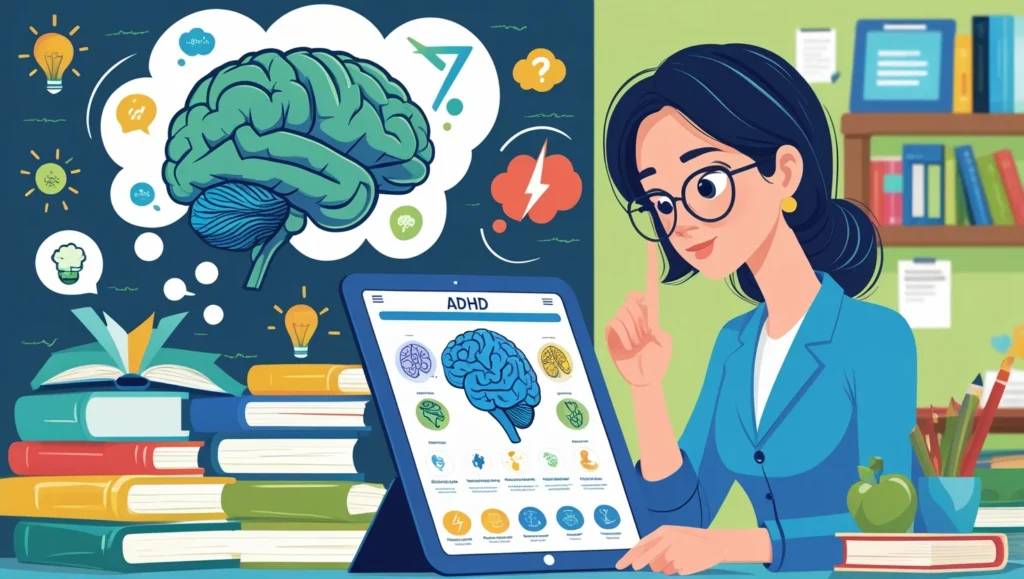Currently Empty: ₹0.00
Blog
Teaching Students with ADHD: Strategies for Success

Key Takeaways
- Teaching students with ADHD requires tailored strategies that address their unique needs, fostering focus and engagement in the classroom.
- Creating structured environments, incorporating movement, and using positive reinforcement can significantly improve learning outcomes.
- Collaboration with parents, specialists, and students themselves enhances the effectiveness of teaching methods.
- Technology and flexible teaching approaches help students with ADHD thrive academically and socially.
- Ongoing teacher training and empathy are critical for building trust and supporting long-term success.
Introduction: Unlocking the Potential of Students with ADHD
Imagine a classroom buzzing with energy, where one student’s mind races like a high-speed train, jumping from one idea to another. For students with Attention Deficit Hyperactivity Disorder (ADHD), this is often their reality. Teaching students with ADHD isn’t just about managing behavior—it’s about unlocking their potential, harnessing their creativity, and helping them shine. But how do educators bridge the gap between distraction and success? This article dives deep into evidence-based strategies, real-world examples, and expert insights to empower teachers to create inclusive, engaging classrooms where students with ADHD can thrive.
ADHD affects approximately 5-10% of school-aged children worldwide, according to the Centers for Disease Control and Prevention (CDC). These students often struggle with focus, impulsivity, and organization, but they also bring unique strengths like creativity, enthusiasm, and problem-solving skills. By understanding ADHD and implementing targeted teaching strategies, educators can transform challenges into opportunities. Let’s explore how to make that happen.
Understanding ADHD: What Teachers Need to Know
Before diving into strategies, it’s essential to understand what ADHD is—and what it isn’t. ADHD is a neurodevelopmental disorder characterized by difficulties with attention, hyperactivity, and impulsivity that are inconsistent with a child’s age. Laziness, bad parenting, or a lack of intelligence are not the causes. In fact, many students with ADHD are highly intelligent but struggle to channel their energy effectively.

Dr. Russell Barkley, a leading ADHD researcher, explains, “ADHD is not a problem of knowing what to do; it’s a problem of doing what you know.” This insight is critical for teachers. Students with ADHD often know the material but need support to demonstrate their knowledge consistently. Symptoms vary widely—some students may be hyperactive, others inattentive, and many exhibit a combination of both.
Common ADHD Challenges in the Classroom
• Inattention: The inability to maintain concentration on tasks or adhere to multi-step directions.
• Impulsivity: Behaving impulsively, talking over other people, or responding without thinking.
- Hyperactivity: Fidgeting, excessive talking, or difficulty staying seated.
- Executive Function Struggles: Challenges with organization, time management, and planning.
By recognizing these challenges, teachers can tailor their approaches to meet students’ needs while fostering a positive learning environment.
Creating a Structured and Supportive Classroom
Establishing an organized classroom atmosphere is one of the best strategies to assist individuals with ADHD. Predictability reduces anxiety and helps students focus. Here’s how to do it:
- Establish Clear Routines: Consistency is key when teaching students with ADHD. When daily timetables are prominently displayed in the classroom, kids are better prepared. For example, a third-grade teacher might use a whiteboard to outline the day: “9:00 AM – Math, 10:00 AM – Break, 10:15 AM – Reading.” Visual cues like timers or checklists reinforce routines and keep students on track.
- Break Tasks into Manageable Chunks: Long assignments can overwhelm students with ADHD. Break tasks into smaller, actionable steps. For instance, instead of assigning “Write a 500-word essay,” provide milestones: “Choose a topic by 10 AM, write an outline by noon, draft the first paragraph by 2 PM.” This approach reduces frustration and builds confidence.
- Use Visual and Auditory Cues: Multisensory cues are frequently successfully received by students with ADHD. Incorporate color-coded materials, hand signals, or verbal reminders to maintain attention. A teacher might say, “Eyes on me in 3-2-1” while raising a hand to signal the start of a lesson.
Engaging Students with Active Learning

Students with ADHD thrive in dynamic, hands-on environments. Traditional lectures may lead to disengagement, but active learning keeps them involved. Here are some proven techniques:
Incorporate Movement Breaks
Physical activity helps students with ADHD regulate energy levels. Short movement breaks—stretching, jumping jacks, or a quick walk—can reset focus. A 2018 study published in the Journal of Abnormal Child Psychology found that brief physical activity improved attention and behavior in students with ADHD.
For example, Sarah, a middle school teacher, uses “brain breaks” every 20 minutes. She might ask students to stand and mimic animal movements or toss a soft ball while reviewing vocabulary. These exercises lessen restlessness and make learning enjoyable.
Use Interactive Teaching Methods
Incorporate group discussions, role-playing, or project-based learning to keep students engaged. For instance, during a history lesson, students could act out a historical event or create a poster summarizing key points. These activities tap into their creativity and make learning memorable.
Leverage Technology
Students with ADHD may find that technology changes their lives. Apps like Quizlet for flashcards or Focus@Will for background music designed to enhance concentration can support learning. Interactive whiteboards or gamified learning platforms, such as Kahoot, also boost engagement.
Positive Reinforcement: Building Confidence and Motivation
Self-esteem might be damaged by the frequent criticism given to students with ADHD for their actions. By directing attention to their abilities, positive reinforcement promotes effort and advancement.
- Celebrate Small Wins: Acknowledge specific achievements, no matter how small. For example, “Great job staying focused during the first 10 minutes of math!” This builds confidence and motivates students to keep trying.
- Use Reward Systems: Token economies, where students earn points for positive behaviors (e.g., completing tasks or helping a peer), work well. Privileges like selecting a class activity or having more recess time can be obtained by exchanging points. Be consistent and transparent about how rewards are earned.
- Foster a Growth Mindset: Students should be encouraged to see obstacles as chances for personal development. “You haven’t mastered this yet, but you’re getting closer!” is one phrase that encourages resilience. By sharing their own educational experiences, educators can serve as role models for this approach.
Collaborating with Parents and Specialists

Teaching students with ADHD is a team effort. Collaboration with parents, school counselors, and specialists ensures a holistic approach. Here’s how to make it work:
- Communicate Regularly with Parents: Share observations about the student’s progress and challenges. For example, a weekly email might note, “Jake stayed focused during group work this week but struggled with transitions.” Invite parents to share strategies that work at home, creating a consistent approach.
- Work with School Support Staff: Special education coordinators or school psychologists might offer resources and insights. If a student has an Individualized Education Plan (IEP) or 504 Plan, ensure accommodations—like extended time on tests or preferential seating—are implemented effectively.
- Involve the Student: Empower students by involving them in goal-setting. Ask, “What helps you focus best?” or “What’s one thing you’d like to improve?” This fosters ownership and builds trust.
Addressing Common Classroom Challenges
Even with the best strategies, challenges arise. Here’s how to handle common issues:
- Managing Impulsivity: If a student interrupts frequently, use gentle redirects like, “I love your enthusiasm—let’s wait for your turn.” Teach self-regulation techniques, such as counting to five before speaking.
- Reducing Distractions: Minimize classroom distractions by seating students with ADHD away from windows or high-traffic areas. Provide noise-canceling headphones or fidget tools, like stress balls, to help them focus.
- Supporting Organization: Help students stay organized with tools like planners or color-coded folders. Teach them to prioritize tasks using a “must do, should do, could do” list.
The Role of Teacher Training and Empathy

Effective teaching requires ongoing professional development. Workshops on ADHD, such as those offered by CHADD (Children and Adults with Attention-Deficit/Hyperactivity Disorder), equip teachers with the latest strategies. Empathy is equally important—understanding that a student’s behavior is not defiance but a symptom of their condition fosters patience and trust.
A veteran teacher, Maria, shared her experience: “I used to get frustrated when my student with ADHD couldn’t sit still. After attending a workshop, I realized he wasn’t trying to disrupt—he was struggling to regulate. Changing my perspective changed everything.”
Real-World Success Stories
Think about Alex, a math-challenged high school student with ADHD. His teacher, Mr. Thompson, implemented a combination of strategies: breaking lessons into 15-minute segments, using interactive apps, and offering praise for completed tasks. By the end of the year, Alex not only passed math but also volunteered to tutor younger students. Stories like Alex’s show that with the right support, students with ADHD can excel.
Conclusion: Empowering Every Student to Succeed
Teaching students with ADHD is both a challenge and an opportunity. By creating structured environments, engaging students actively, and fostering collaboration, teachers can help these students unlock their full potential. The journey requires patience, creativity, and empathy, but the reward—watching a student transform from distracted to determined—is worth every effort. As educators, we have the power to shape not just academic outcomes but lives. Let’s embrace that responsibility and make every classroom a place where every student can shine.



